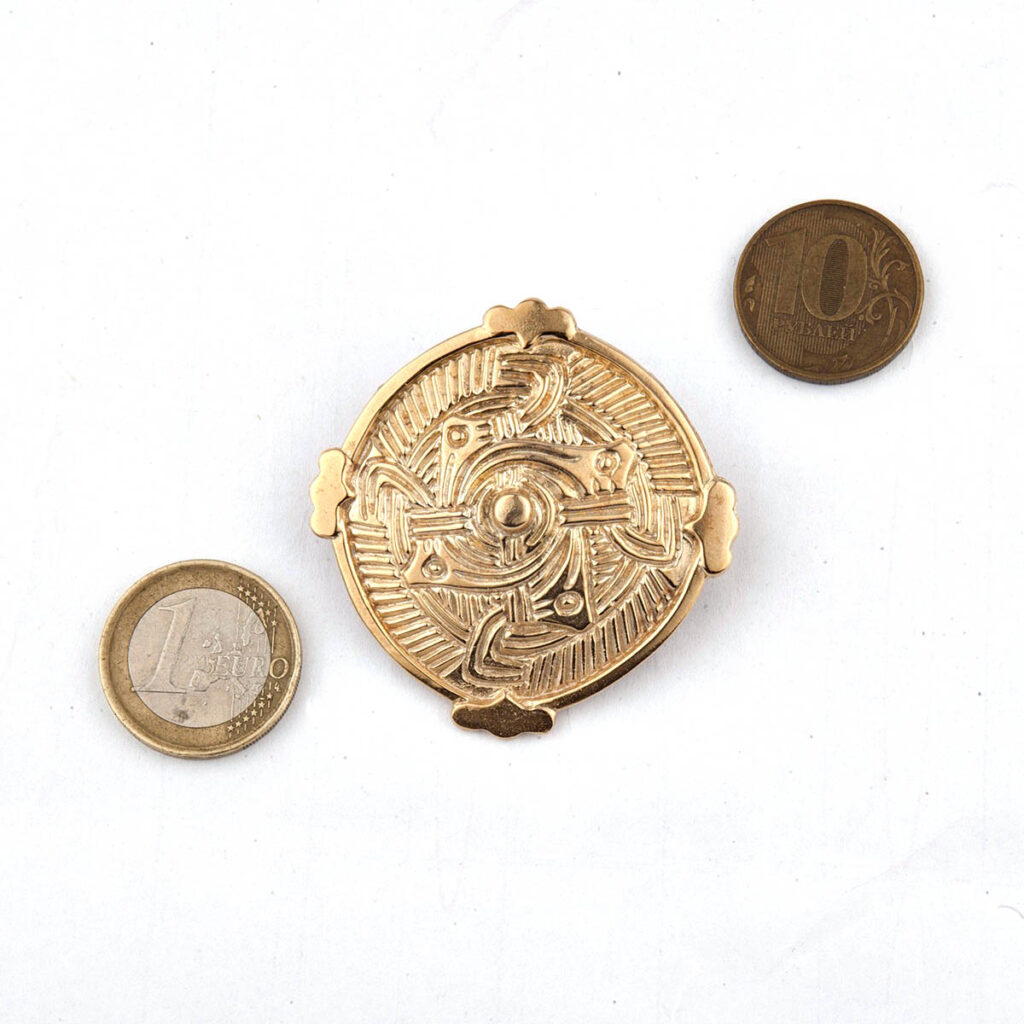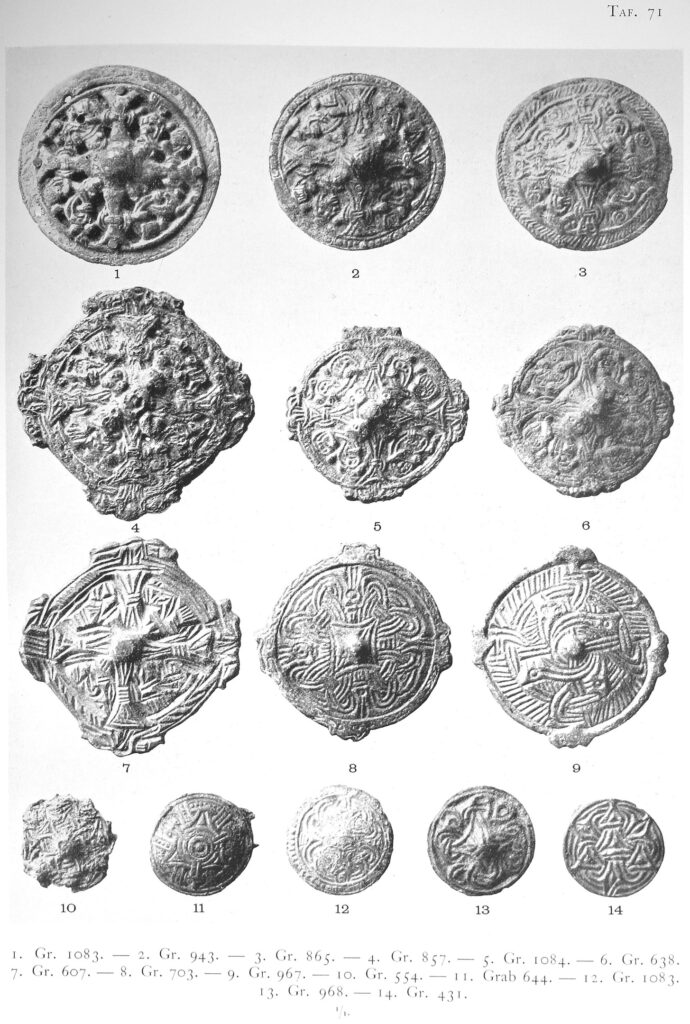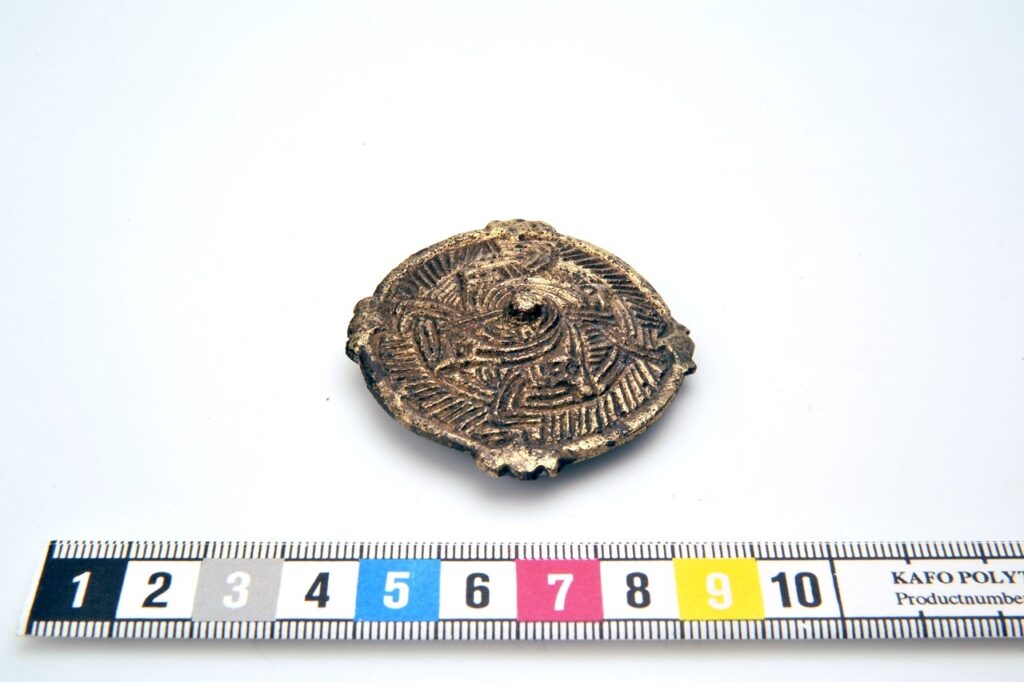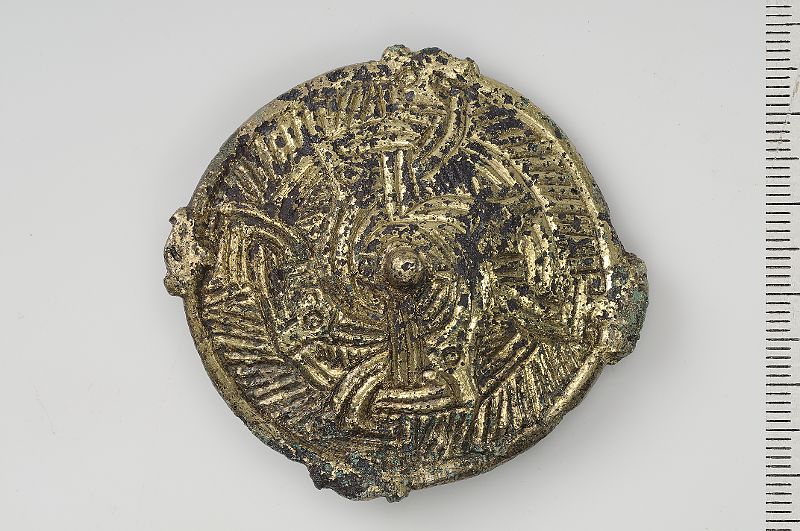
Vasily „Gudred“, our craftsman of choice for anything that glitters, has made a new replica of a round fibula found in Birka.
Another craftsman named L’an Mil from Belgium has completed a replica some years ago. He also suggested some additions to this article, thanks!
Dating of the fibulae
This fibula has an interesting zoomorphic decoration which, in style, is more reminiscent to vendel-age art to me than to viking-age art (however, it’s an early 10th century find, according to coins found in the graves no earlier than 911/912 AD).
Round fibulae in Birka and Jansson’s work
Generally, round fibulae in Birka are from female graves, especially large and ornate ones. There are two-shelled round fibulae from female Birka graves which are more than 7cm (precisely, 7.3 cm) in diameter and very intricately decorated. There are also smaller round fibulae like the „teddy bear“ fibulae which are quite well-known, and the literature (Jansson, „Kleine Rundspangen“[1]Jansson, Ingmar, „Kleine Rundspangen“, in Birka II:1, Systematische Analysen der Gräberfunde, Kungl. Vitterhets Historie och Antikvitets Akademien 1984, pp. 58-74 and „Große Rundspangen“[2]Jansson, Ingmar, „Kleine Rundspangen“, in Birka II:1, Systematische Analysen der Gräberfunde, Kungl. Vitterhets Historie och Antikvitets Akademien 1984, pp. 75-84) calls all of the fibulae between 2.4 and 3.4 cm „small“, and the ones between 4.5 and 7.3cm „large“).
Large round fibulae of type II:C in Birka
Back to the fibulae at hand. By Jansson’s typology, they are „large round fibulae“ of type II C. Six of these fibulae were found in Birka:

Example 1: Bj967
The first one is from grave 967 (Tafel 71:9, in the black and white photo), and one in grave 1035. Grave 967[3]http://mis.historiska.se/mis/sok/kontext.asp?kid=1151 looks like a typical female grave – it contains a necklace of beads, another small round fibula of type „teddy bear“ and a large fragment of brocaded silver textile band. It was obviously a high status grave. So far, so unremarkable (for Birka standards).

Example 2: Bj1035 – a man’s grave?
The second one, however, was found in grave 1035 and this is where it gets interesting. The grave is a cremation grave, meaning that there are no skeletal remains. Bj1035[4]http://mis.historiska.se/mis/sok/kontext.asp?kid=535 contains a shield boss, remains of a weapon-knive (a „seax“ in the baltic variant), but also a needlecase and other accessories which are usually attributed to female graves.
In detailed view, it seems that this grave was a double cremation of a male and a female deceased person. This means that the fibula is most likely not „unisex“, but a fibula for women. So – sorry about the clickbait, but this was definitely a woman’s fibula.
The other finds from Birka
Four other finds are from the graves 835, 923, 960 and 963. Jansson interprets these fibulae as four animals which originate from the center button, and states that all six of the finds are in fact slightly different to each other. They vary in size and execution, with the item from Bj963 being the best, and the ones from Bj 838 and Bj 923 being the least well executed.

In table 9:1, he also gives more details for the find context:
- The fibulae are from 2 cremations, one shaft grave („Schachtgrab“) and 3 chamber graves.
- In Jansson’s opinion, none of the graves were double graves, which is interesting: How does he interpret the shield boss if not with a double grave?
- 4 of the graves contained P51 tortoise brooches in addition to the large round fibula
- 5 of the graves contained small round fibulae in addition to the large round fibula.
- All of the graves are in relative geographical proximity on Birka’s cemetaries – in a radius of about 150m.
Finds of round fibulae of type Jansson II:C outside Birka
The type IIC of large round fibulae is found in seven more instances in Sweden, once in Russia, and (in a modified and simplified version) also in Öland and Finland.
The finds from Sweden are from
- Gotland (Dep. GF C 474, possibly a gotland-specific find signature)
- Fors, Hille socken, Gästrikland
- Sota, Rödön socken, Jämtland
- Toftaholm, Dörarp socken, Smaland
- Eke, Skuttunge socken, Uppland
- Obbola, Holmsund socken, Västerbotten
- Slagerstad, Stenasa socken, Öland
The single Russian find is from Gnezdowo. It was published in 1902 by Vladimir Ilich Cisov in his book about the finds: „Курганы Смоленской губернии. Выпуск 1. Гнездовский могильник близ Смоленска.“ and can be found on plate 1, item 12.
The find from Öland is from Mörbylanga socken, the one from Finland is from the Österbotten region.
Conclusion
As it turns out, this is a quite ubiquitous find, but it’s by no means an ambiguous one: All the round brooches of type Jansson II:C are from female graves. Finds of this type of round fibula were often combined with smaller round fibulae and P51 tortoise brooches, and there are more than 15 of these items found in early medieval findplaces in Scandinavia and Russia.
Unfortunately, due to the ongoing Covid crisis, there is no easy way to get your hands on this nice piece of craftsmanship from Russia. If you are interested in this fibula, contact us for more information.
References
